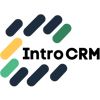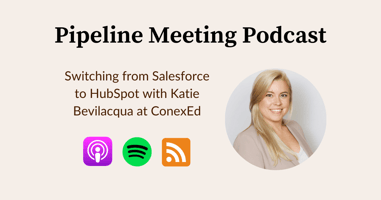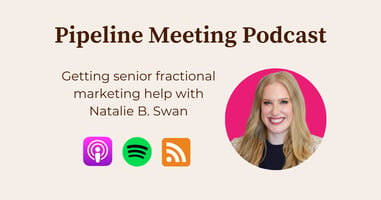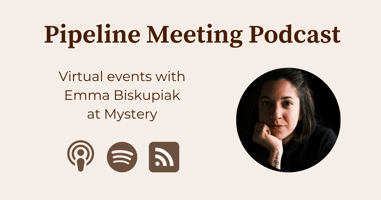Katie Bevilacqua is the Director of Operations at ConexEd, a higher ed edtech startup that migrated...
B2B sales and marketing alignment with Lucas Stacey at HubSpot
If you want to sell more, your sales and marketing teams need to work together. Lucas Stacey from HubSpot talks all about B2B sales and marketing alignment and how software can support your growth.
Show Description
Where B2B marketers come to talk sales. 15-minute interviews published every Monday morning. For heads of marketing and founders who support a sales team.
Subscribe
Popular Platforms
Apple Podcasts
Spotify
RSS Feed
Also available:
Amazon | Anghami | Castbox | Castro | Deezer | GoodPods | Google Podcasts | iHeart Radio | Overcast | Pandora | PlayerFM | Pocket Casts | Podcast Index | Podchaser | Stitcher | TuneIn
Show Notes
- Bringing sales in the loop: Even a high performing marketing team using marketing automation, lead scoring, and analytics is going to want to bring their sales team onto the same platform to make the most of it.
- Sales and customers win: Lucas shares how both sales teams and customers benefit when marketing insights are fully incorporated into the buyer's journey.
- Marketing has skin in the game: Having visibility into sales activities and the full sales pipeline also means marketers can make better, data-driven, and revenue-informed decisions about how they spend their time.
- Operations, or RevOps, is the glue: These two teams can connect with other platforms, tools, and other teams through HubSpot's OpsHub. You can also automate things like data cleaning and enrichment across your CRM.
- Partners are key. HubSpot is a powerful platform. But the average scaling company is using 242 pieces of software in their tech stack. HubSpot both plays well with others and can handle some of these workflows. We also talk about emerging tools like Arrows, built for onboarding, which is a native HubSpot app.
Lucas Stacey on LinkedIn: https://www.linkedin.com/in/lucas-stacey/
HubSpot on LinkedIn: https://www.linkedin.com/company/hubspot/
Learn more about HubSpot: https://www.hubspot.com/
Why Choose HubSpot: https://www.hubspot.com/why-choose-hubspot
What's New in HubSpot's Software: https://www.hubspot.com/new
Transcript
Welcome to Pipeline Meeting, where marketers come to talk about sales. Whether you're the head of marketing or a founder who's supporting your first sales hire, we'll talk about qualifying your inbound leads and finding new ones with cold outreach. Learn more at introcrm.com/podcast.
[00:00:20] Harris Kenny: I'm excited to have Lucas Stacey from HubSpot on the show. Lucas has been working with me and we're gonna talk about gaps between sales and marketing. He's great, he knows his stuff, you should find him on LinkedIn. Lucas, thanks for joining me.
[00:00:32] Let's get started with something that you and I have been talking about a lot, which is a strong marketer and how sales and the CRM side of HubSpot fits in.
[00:00:39] You're following marketing best practices and you've got the flywheel turning, you're generating content. You feel like you've got a handle on your side of the shop.
[00:00:49] And you want to bring sales in. There's buy-in within the organization. People are open to getting sales onto the same platform and using HubSpot CRM.
[00:00:59] What does that look like in the short term and long term? As a marketer, how does that affect your job? Does it really matter where sales is working?
[00:01:06] Lucas Stacey: It's really important to think of this through two different lenses.
[00:01:09] One of them is through the organization themselves that's implementing that change. And the other one is through the eyes of the customer or really a prospect at that time. How are we influencing them? How are we nurturing them and ultimately leading them to be a, a fan of our brand?
[00:01:23] First and foremost, if you think of it selfishly from your marketing department, if any of you take up Harris' suggestion to follow me on LinkedIn, you will see this quote in abundance, but it comes from a gentleman named John Wannamaker who ran a bunch of retail stores.
[00:01:38] He said, 50% of my advertising budget is wasted, the trouble is I don't know which half.
[00:01:43] I think that marketing teams have intrinsically begun to understand those things, and that's why we're getting so heavy into matrixes and data and we're A/B testing pieces and we're looking at our reports.
[00:01:53] But at the end of the day, when you go to stick your hand out in front of the CFO and say, I need budget to do this, they need attribution reporting. They need to understand what sale was, you know, generated by those marketing initiatives.
[00:02:08] And if the sales team and the marketing team are working hand in hand, that's a lot easier of a story to tell.
[00:02:14] You think back a tale as old as time with sales and marketing, living in silos and marketing busts their butt to come up with this beautiful print deck that the traveling salesman leaves in their trunk and never actually brings it to talk to a customer, wasting time and effort.
[00:02:27] The sales team's taking no time to talk to the marketing team and say, "Hey, this is what the customer's really looking for." It just becomes a tremendous pain from a company perspective, and I think that's an enormous one to solve.
[00:02:39] Harris Kenny: Why not though, just say, "Okay, these are the closed deals. We got those from accounting. I'm gonna drop that into a spreadsheet and I'm gonna figure out a way to pair it and HubSpot and with the marketing data.
[00:02:53] Why does it matter in your opinion, that you can see what's happening in the pipeline?
[00:02:58] Because technically, a lot of marketers do this, right, they get the closed deals, they put together an attribution report, with their best guess. And it's good enough because they're the authority and nobody else is gonna have more data than them, even though the data they have maybe isn't great.
[00:03:13] Lucas Stacey: So a couple of different reasons.
[00:03:15] I think the first is you're manually compiling that when you're going that route.
[00:03:19] Using a tool like HubSpot where you can have both entities operating from the same system, it allows you to streamline that reporting. Limit the amount of potential human error in doing those attribution on your own increases the validity of your data. Limits the amount of work and effort you have to put into building those pieces.
[00:03:39] Taking your marketing hat off for a second and pretending you're the sales team or that salesperson, there is enormous value in being in the same system as my marketing team, because if I know what pages they visited on my website, I understand what emails they've opened, I know that they've been to my site three times in the last week.
[00:03:57] I've just done so much good to that salesperson because now they understand how qualified that buyer is. They can curate that sales presentation to be very specific to what that prospect is most likely interested in because they have all that data.
[00:04:12] And the slept on place here, and the other lens we need to think of this through, from a pairing of sales and marketing, is that of the customer.
[00:04:19] We love to think of the textbook version of a buyer's journey, where we have our really pretty funnel and we go from, you know, unknown to prospect, to suspect to closed business, and it's great, right?
[00:04:33] But the reality is so often marketing gets that marketing qualified lead. Passes over to sales. There's a turnover at that decision maker, and now we're starting back from scratch.
[00:04:45] Or we ran out of budget. It's a tough economic climate right now. We're revisiting purchases. We're on a freeze for the next three months. Talk to me in January.
[00:04:54] If you're living in different systems, there's no way for that prospect to transition smoothly back from sales to being in marketing's house.
[00:05:02] We want to then continue to nurture that prospect. We want the sales team to know to reach back out in January or whatever that next trigger event is.
[00:05:09] And when we're in the same place, we can keep that data cohesive and we're able to really influence that sale. But that is going to fall through the cracks almost immediately if we're living in disparate systems and treating this like it's just gonna be this idyllic, traditional sales journey.
[00:05:27] Harris Kenny: It sounds like when you say that sales wants to have access to these types of information, when you say sales wants to know which pages people have visited, which forms they've filled out, it also means that marketing needs to do a little bit more work in getting everything properly set up.
[00:05:45] You may have a marketing instance of HubSpot that's a little messy. Maybe you haven't fully implemented certain aspects of the workflow. You've got maybe brochures or collateral that's still sitting on a Google Drive or Dropbox, and you didn't upload that in a way where you can get those open tracking and other features.
[00:06:04] From what you're saying, the benefits for sales are marketing has to put some skin in the game too.
[00:06:08] Lucas Stacey: I think marketing always is to put a little skin in the game. That's why we're here. We need to open that door. We need to build brand affinity. We need to equip and armor that sales team to go be able to do a tremendous job and close that sale.
[00:06:21] And one of the beautiful things about making sure we're doing things right, that we are able to attribute things properly, that we can understand how folks are interacting and engaging with our content is marketers are stretched thin. We need to spend time where things are most successful.
[00:06:37] If we're not set up to track and manage that data, you have no idea if the 15 hours you spent designing a one sheet went to anything.
[00:06:48] But if you do have it uploaded to documents in HubSpot, and that salesperson can get an email notification when somebody opens and takes a look at that quote, all of those things are going to set up both sides for greater success.
[00:07:02] I know one of my favorite things is if I pitched to somebody two weeks ago, and I haven't heard boo from them. And then all of a sudden I get a little ping in my HubSpot app and it says, Company XYZ just opened your email, I know they just got of an internal meeting talking about me. I can't pick up my phone fast enough to give them a call and say, "Hey, what's up?"
[00:07:22] All of that is just because our marketing team go in the extra mile. Great piece of software and alignment across that sales and marketing team.
[00:07:32] Harris Kenny: One thing we've talked about that I think ties this together is Ops Hub. This is an emerging, or a growing part of HubSpot where before people just weren't connecting things or maybe doing things manually or spending extra with developers to do it.
[00:07:48] Can you talk about how Ops Hub ties these two teams together?
[00:07:50] Lucas Stacey: So Operations Hub is essentially a data integrity and a data visualization tool.
[00:07:55] As you think about your marketing team and you have a pretty entrenched HubSpot instance, or you're moving over from another CRM and adopting HubSpot, you're only gonna be as good as your data.
[00:08:08] What Operations Hub does is make sure we have the right pieces of information in the right locations. That can be simple things like de-duplicating contacts, so that we're making sure we're using somebody's most recent email address.
[00:08:23] It can be slightly more beneficial things, like maybe checking people's names. The reason that person's in your CRM is because they entered a form interested to have a podcast with Lucas, and they spelled Harris Capital H, capital A, lowercase r r i s.
[00:08:37] Well, now if you send an automated confirmation email, that first name, that customization within that email, is going to look like you misspelled their first name because you capitalized that H and that A.
[00:08:48] Ops Hub, you can programmatically go in and fix those things. It knows what structure a first name should have, and it'll repair that. So it makes your marketing a little bit more effective and powerful, especially because that prospect is not going to realize they misentered their own name, and that's where the problem stemmed from.
[00:09:08] And then as it advances, we're able to do some more complex reporting. We're able to do some better work on the attribution side of things. You can have, uh, basically a dashboard that shows the health of your data and your information between all of your various integrations throughout your tech stack that's communicating with HubSpot.
[00:09:26] We're putting the work in and Operations Hub is really all about just making sure from, a RevOps perspective, we're able to understand the intersection between our marketing and sales team. And that we're equipping them with the best pieces of information and opportunities to go be successful.
[00:09:43] Harris Kenny: For those unfamiliar RevOps, revenue operations.
[00:09:46] One thing that you touched on in there that I. Drill down on a little bit more is you talked about using different tools. And I think that this is a misconception maybe about HubSpot where you have to use everything in HubSpot and you have to use the HubSpot version of a different products, and that's not necessarily the case.
[00:10:07] It seems like HubSpot is working on supporting integrations more.
[00:10:11] One company whose tool we use, Arrows we use for onboarding, and it's in the HubSpot . Marketplace. It's a really neat tool, it integrates directly in, and you can do onboarding through either deals or through tickets.
[00:10:25] I feel like they're a really good example of companies that are building native integrations for HubSpot and bringing capabilities that are outside of what HubSpot can do and that make it better and that it's not just, take it as it is.
[00:10:39] Does it seem like there's momentum on the integration side from your perspective? And if so, what does that look like? What does that mean in practice for people?
[00:10:47] Lucas Stacey: Yeah, there has to be, right?
[00:10:49] HubSpot, when we started, we were a marketing automation stack, and we've evolved to be able to be a CRM for sales teams, and a CMS for devs, and an Operations Hub for RevOps teams and all these things.
[00:11:01] But when we started, it was straightforward marketing automation. And Salesforce was the beast.
[00:11:09] So we had to find ways to play really, really nicely in order to even have an opportunity to play in that market. Our integration with Salesforce in many ways works better than Salesforce's own integration into Pardot.
[00:11:25] The beauty of HubSpot is we wanna be a centralized location where you're able to manage efficiently all of those other pieces.
[00:11:34] If you're a marketing team, you're going to have to have social media as part of your tech stack. Cool, we're gonna integrate with those things so you can schedule posts, interact with people, reply to messages, comment back at them.
[00:11:46] Google analytics. Pretty powerful and important tool, right? So we better get Google Search Console in there too, so that we can see all those things from one place.
[00:11:54] Then there's gonna be a whole bunch of stuff that isn't germane to HubSpot's product suite, but you're still gonna wanna see, know, and understand. We absolutely wanna be able to connect those things.
[00:12:03] Operations Hub is great for being able to help facilitate some of those connections, but our APIs also wide open and you can dev out custom API connections when necessary.
[00:12:13] Couple weeks ago was Inbound, which is HubSpot's massive annual conference where we launch all our new features and all that fun stuff.
[00:12:21] The takeaway from me came from Yamini, our CEO's keynote. Right now the average scaling company is 242 pieces of software in their tech stack, which is just insane.
[00:12:34] It makes sense because acquisitions have been running rampant. So you're trying to assimilate somebody else's tech stack with your own.
[00:12:41] During the pandemic, everybody just kind of had to buy point solutions to solve from emergencies as they arose. Now we're kind of needing to look back in the rear view mirror and say, "Okay. We did things the way we had to in order to accomplish what we needed to accomplish. But if we were gonna do this the right way, how would we actually do that?"
[00:13:01] I think it's important, at least from a HubSpot perspective, that we play an integral role in that. So you look at the 240 things, cool, well, you're already paying for HubSpot is one of those 240 things.
[00:13:12] HubSpot natively can do 70 of those things you're already paying for. So stop paying for those 70 other things and use the tool that you're already, you know, have as a line item in your budget.
[00:13:21] Then there's still a whole bunch of other really good tools in there. Let's connect those things up, make sure everybody's playing nicely so that you know, again, as marketers, we only have so much time and making sure we're using it effectively and efficiently is the name of the game.
[00:13:35] So if you can log into one place to manage all those things, instead of logging into 14, not only is it gonna make your life a lot easier, but when you continue to grow as an organization and need to onboard that next hire, you're not training them into 14 systems. You're training them into one, making their life a heck of a lot easier too.
[00:13:52] Harris Kenny: That makes sense to me. When I saw that number, I was just blown away. Imagining just how much work, how much clicking and logging out, logging in, you know, setting up accounts, just making a new hire and how many credentials you have to share with them and, seems like it's still very early days for the ecosystem.
[00:14:12] Lucas, I wanna respect your time. I'm gonna let you go.
[00:14:14] Where can people find you and where can people learn more about the stuff that you find interesting about HubSpot? Because the company makes a lot of content.
[00:14:22] Lucas Stacey: If you want to connect with me, and I certainly hope that you do, hit me up on LinkedIn, Lucas Stacy, l u c a s s t a c e y.
[00:14:30] As far as all of the best things going on at HubSpot. If you Google HubSpot, "Why choose HubSpot?" It is my favorite page on our site. Beautiful. 30,000 foot view of what we have going on, and then some really detailed information about our value prop and what separates us within the market.
[00:14:48] And if you're like, "Hey, great Lucas, I don't need the 101, I'm already a HubSpot user. What's on the horizon? You can do the same thing, Google, "HubSpot new" and it'll take you to a page that shows what's on our product roadmap over the next 6, 12, 18 months.
That's all for now. You can find show notes at introcrm.com/podcast. The theme music for Pipeline Meeting is by Neighbourhood Vandal and it's shared under a Creative Commons-Attribution, or CC-BY, license. If you learned something, consider sharing this show with a friend. Thanks.



